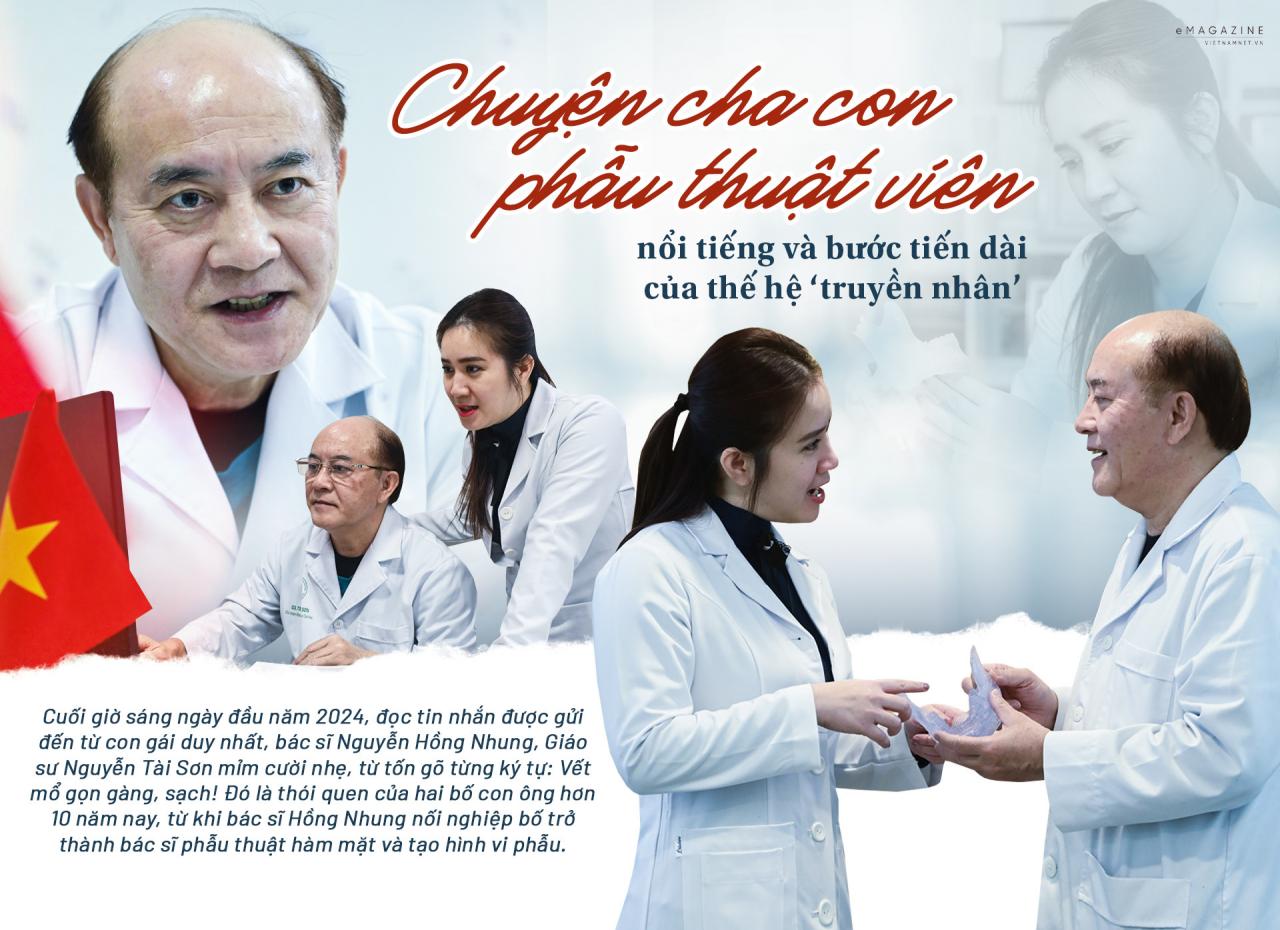 EDITORIAL NOTE
EDITORIAL NOTE On the occasion of the 69th anniversary of Vietnamese Doctors' Day (February 27), VietNamNet would like to send readers the series of articles "Genetics: Continuing and shining". This is a story about families with many generations, members wearing the same white coat. At that time, parents became great teachers, pioneers, paving the way and the children not only chose to follow but also took on the responsibility of continuing to develop and shine.  The family of Professor Nguyen Tai Son, former Head of the Department of Maxillofacial Surgery and Plastic Surgery, 108 Central Military Hospital, has only one daughter, Dr. Nguyen Hong Nhung, 40 years old, currently working at Hospital E, and also a lecturer in the Department of Oral and Maxillofacial Surgery, University of Medicine and Pharmacy, Vietnam National University, Hanoi. The field of maxillofacial surgery and microsurgery in Vietnam is pursued by very few female doctors because it is very difficult and tiring. But for Dr. Hong Nhung to stand out in this field is a journey with many surprises and heartaches of Professor Son himself. "At first, Nhung did not want to take the medical exam, but I advised her to pursue this very humane field," the professor, who is about to turn 70 this year, began the story with VietNamNet. Dr. Nhung studied medicine in Russia, and every summer vacation, she returned to Hospital 108 to practice as a medical staff in different "roles". First as a nurse visiting and measuring blood pressure and temperature for patients, then a year later as a nurse, then as a doctor assisting in examining and monitoring patients. And so on.
The family of Professor Nguyen Tai Son, former Head of the Department of Maxillofacial Surgery and Plastic Surgery, 108 Central Military Hospital, has only one daughter, Dr. Nguyen Hong Nhung, 40 years old, currently working at Hospital E, and also a lecturer in the Department of Oral and Maxillofacial Surgery, University of Medicine and Pharmacy, Vietnam National University, Hanoi. The field of maxillofacial surgery and microsurgery in Vietnam is pursued by very few female doctors because it is very difficult and tiring. But for Dr. Hong Nhung to stand out in this field is a journey with many surprises and heartaches of Professor Son himself. "At first, Nhung did not want to take the medical exam, but I advised her to pursue this very humane field," the professor, who is about to turn 70 this year, began the story with VietNamNet. Dr. Nhung studied medicine in Russia, and every summer vacation, she returned to Hospital 108 to practice as a medical staff in different "roles". First as a nurse visiting and measuring blood pressure and temperature for patients, then a year later as a nurse, then as a doctor assisting in examining and monitoring patients. And so on. 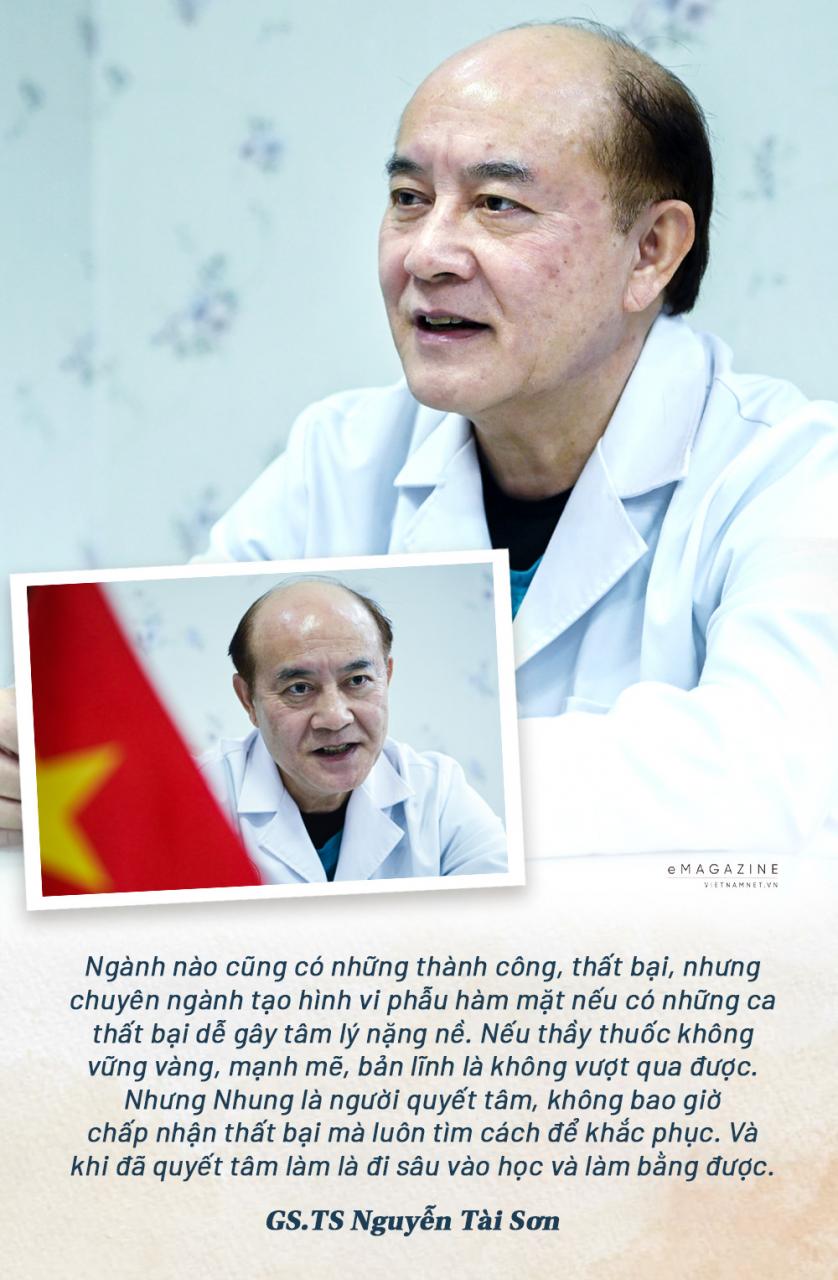 At that time, Dr. Nguyen Tai Son was evaluated by his colleagues in the hospital as having the most talented hands in microsurgery, not only in the hospital but also in the country. He advised his son to pursue a career in medicine, but at that time, he never wanted his son to pursue his major, because "it is really good, but it is very hard". "Each microsurgery surgery lasts very long, usually 7-8 hours, not to mention complicated cases that last even longer. It can last all day and night, up to 22-24 hours continuously, with only 30 minutes of rest before continuing to fight", Professor Son recalled. In addition, post-operative monitoring is very important, even deciding the success of the entire microsurgery team. That monitoring is not only based on the patient's vital signs, but also the vital signs of the damaged area (due to tumor removal, scars, deformities due to trauma) and the free flap (healthy area taken to compensate for the damaged defect). If the free flap after surgery is not good and becomes necrotic, the surgery will be a complete failure. The patient will suffer two injuries. Therefore, in 2010, the 26-year-old daughter who graduated from medical school was advised by her father to become an Ophthalmologist because the job is light and more suitable for women. However, Dr. Nhung has always been a determined person since childhood, who loves challenges. "After going into the microsurgery operating room with my father to visit, watching him and his colleagues perform major surgeries, perhaps for the first time in my life I saw a plastic surgery that looked new and complicated and saw the surgical results that changed people's lives, I decided to pursue this major," he said. In fact, Dr. Nhung worked in the Ophthalmology department for only 30 days, then insisted on pursuing microsurgery. “When I insisted on pursuing this difficult and difficult profession, my father firmly objected, saying, ‘Why are you a girl pursuing this? Why don’t you choose a more gentle job that is more suitable for you?’. My father said that this profession requires physical strength, performing surgeries from morning to evening, and skipping meals is common, especially for those who have to take the lead in major surgeries. Not to mention that women also have to take care of their children and families. After surgery, the work is not over, but they still have to keep an eye on the patient even after they return home, and at night, when there is an unusual development, the doctor has to rush in to see the patient,” Dr. Nhung continued the story. But no matter how much her father and mother (who are also doctors) objected, they could not overcome the “falling in love” of their only “golden branch and jade leaf” daughter. Until now, more than 12 years after that day, Dr. Nhung clearly understood what her father said. “This job can save lives and restore a good life to many people who have fallen into the “abyss”, that is what motivated me to stick with the field of Microsurgery and Maxillofacial Surgery, which is considered not for women”, she said. “There are cases where after the surgery is done during the day, at midnight there is a phone call from the department and Nhung has to run in, only having time to tell the family that they have to go to the hospital to treat the patient, sometimes staying there until morning”, Dr. Son said. But she shared: If given the choice again, she would always choose this job.
At that time, Dr. Nguyen Tai Son was evaluated by his colleagues in the hospital as having the most talented hands in microsurgery, not only in the hospital but also in the country. He advised his son to pursue a career in medicine, but at that time, he never wanted his son to pursue his major, because "it is really good, but it is very hard". "Each microsurgery surgery lasts very long, usually 7-8 hours, not to mention complicated cases that last even longer. It can last all day and night, up to 22-24 hours continuously, with only 30 minutes of rest before continuing to fight", Professor Son recalled. In addition, post-operative monitoring is very important, even deciding the success of the entire microsurgery team. That monitoring is not only based on the patient's vital signs, but also the vital signs of the damaged area (due to tumor removal, scars, deformities due to trauma) and the free flap (healthy area taken to compensate for the damaged defect). If the free flap after surgery is not good and becomes necrotic, the surgery will be a complete failure. The patient will suffer two injuries. Therefore, in 2010, the 26-year-old daughter who graduated from medical school was advised by her father to become an Ophthalmologist because the job is light and more suitable for women. However, Dr. Nhung has always been a determined person since childhood, who loves challenges. "After going into the microsurgery operating room with my father to visit, watching him and his colleagues perform major surgeries, perhaps for the first time in my life I saw a plastic surgery that looked new and complicated and saw the surgical results that changed people's lives, I decided to pursue this major," he said. In fact, Dr. Nhung worked in the Ophthalmology department for only 30 days, then insisted on pursuing microsurgery. “When I insisted on pursuing this difficult and difficult profession, my father firmly objected, saying, ‘Why are you a girl pursuing this? Why don’t you choose a more gentle job that is more suitable for you?’. My father said that this profession requires physical strength, performing surgeries from morning to evening, and skipping meals is common, especially for those who have to take the lead in major surgeries. Not to mention that women also have to take care of their children and families. After surgery, the work is not over, but they still have to keep an eye on the patient even after they return home, and at night, when there is an unusual development, the doctor has to rush in to see the patient,” Dr. Nhung continued the story. But no matter how much her father and mother (who are also doctors) objected, they could not overcome the “falling in love” of their only “golden branch and jade leaf” daughter. Until now, more than 12 years after that day, Dr. Nhung clearly understood what her father said. “This job can save lives and restore a good life to many people who have fallen into the “abyss”, that is what motivated me to stick with the field of Microsurgery and Maxillofacial Surgery, which is considered not for women”, she said. “There are cases where after the surgery is done during the day, at midnight there is a phone call from the department and Nhung has to run in, only having time to tell the family that they have to go to the hospital to treat the patient, sometimes staying there until morning”, Dr. Son said. But she shared: If given the choice again, she would always choose this job.  In 2011, at the age of 27, Dr. Nhung began studying maxillofacial surgery and microsurgery. At that time, her father, Professor Son, was already a master in this field with 26 years of experience. But this leading expert himself admitted: "My daughter grew up surprisingly fast." The doctor still clearly remembers the days when his daughter and her friends practiced connecting blood vessels all afternoon. Connecting blood vessels on the belly of a mouse is very difficult because the blood vessels are tiny, less than 1mm in diameter, only the size of a round toothpick. While the shell is thin, adding a drop of water will make it transparent, but if no water is added, it cannot swell up, the two flattened shells stick together, making it even more impossible to thread a thread to connect. It was so difficult that many students gave up. However, at that time, young doctor Nguyen Hong Nhung was one of the students who successfully conquered it. Professor Son also clearly remembers the moment when he realized that his daughter, who thought she was a young lady, could pursue this surgical career. According to Dr. Son, who has nearly 30 years of experience in the profession, the most basic thing for a "microsurgeon" is to practice under a microscope and see if their hands are shaking. "If a surgeon is shaking, he will normally shake when holding surgical instruments, but under a microscope with a magnification of 20 times, if his hands are shaking, it will be like stirring porridge or beating blood pudding," he said. When he discovered that his daughter had a steady hand and a calm, worry-free face, he believed he had found his "successor".
In 2011, at the age of 27, Dr. Nhung began studying maxillofacial surgery and microsurgery. At that time, her father, Professor Son, was already a master in this field with 26 years of experience. But this leading expert himself admitted: "My daughter grew up surprisingly fast." The doctor still clearly remembers the days when his daughter and her friends practiced connecting blood vessels all afternoon. Connecting blood vessels on the belly of a mouse is very difficult because the blood vessels are tiny, less than 1mm in diameter, only the size of a round toothpick. While the shell is thin, adding a drop of water will make it transparent, but if no water is added, it cannot swell up, the two flattened shells stick together, making it even more impossible to thread a thread to connect. It was so difficult that many students gave up. However, at that time, young doctor Nguyen Hong Nhung was one of the students who successfully conquered it. Professor Son also clearly remembers the moment when he realized that his daughter, who thought she was a young lady, could pursue this surgical career. According to Dr. Son, who has nearly 30 years of experience in the profession, the most basic thing for a "microsurgeon" is to practice under a microscope and see if their hands are shaking. "If a surgeon is shaking, he will normally shake when holding surgical instruments, but under a microscope with a magnification of 20 times, if his hands are shaking, it will be like stirring porridge or beating blood pudding," he said. When he discovered that his daughter had a steady hand and a calm, worry-free face, he believed he had found his "successor". 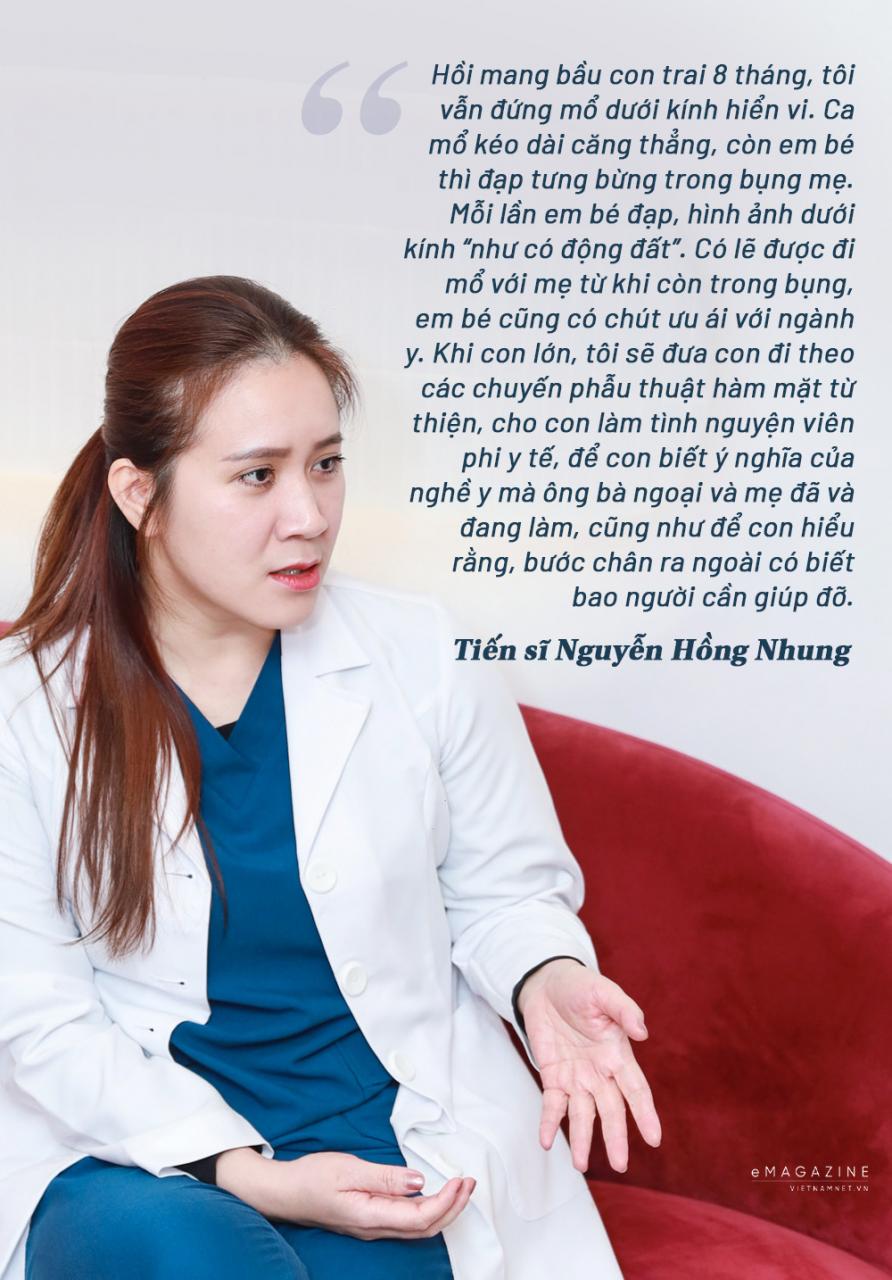 After being guided by her father and practicing under supervision and independently suturing well, then going on to the steps of taking free flaps, dissecting, taking vessels, suturing, etc., the young female doctor surprised her "father and teacher" Nguyen Tai Son with her maturity. Although working at a different hospital, because they were in the same field, Dr. Nhung and her colleagues still invited Professor Nguyen Tai Son to the hospital for consultation, then invited him to perform a demonstration surgery to learn. "After a while, my father came to supervise so that my friends could feel secure in performing the surgery. If there were any difficulties or problems, he would ask right at the 'scene'. A few times like that, I was always by my daughter's side and her friends' side like a driving instructor. When I saw that my daughter was confident, I felt secure and let her drive herself," he recalled. In the first years of letting her be independent, Professor Son still had the habit of following his daughter's steps, knowing her surgery schedule every day, every week. "Every day my daughter had surgery, I would watch the end time, and when I saw that it was late and I hadn't received a text message from her, I would call to ask. Usually, the child would transfer the phone to the technician, always asking how the surgery was, if there were any difficulties, if the father needed help, "he said. Perhaps, it was the close and careful supervision from his father that made Dr. Nhung "strong" very quickly, even beyond the imagination of Professor Son and his colleagues. As people in the same profession, it was very normal for Dr. Son and his daughter to bring the patient home to discuss. Good cases and bad cases were all "dissected". "My daughter is not afraid to ask and argue", the professor humorously said about his unique daughter, whom he loved but was also very strict with.
After being guided by her father and practicing under supervision and independently suturing well, then going on to the steps of taking free flaps, dissecting, taking vessels, suturing, etc., the young female doctor surprised her "father and teacher" Nguyen Tai Son with her maturity. Although working at a different hospital, because they were in the same field, Dr. Nhung and her colleagues still invited Professor Nguyen Tai Son to the hospital for consultation, then invited him to perform a demonstration surgery to learn. "After a while, my father came to supervise so that my friends could feel secure in performing the surgery. If there were any difficulties or problems, he would ask right at the 'scene'. A few times like that, I was always by my daughter's side and her friends' side like a driving instructor. When I saw that my daughter was confident, I felt secure and let her drive herself," he recalled. In the first years of letting her be independent, Professor Son still had the habit of following his daughter's steps, knowing her surgery schedule every day, every week. "Every day my daughter had surgery, I would watch the end time, and when I saw that it was late and I hadn't received a text message from her, I would call to ask. Usually, the child would transfer the phone to the technician, always asking how the surgery was, if there were any difficulties, if the father needed help, "he said. Perhaps, it was the close and careful supervision from his father that made Dr. Nhung "strong" very quickly, even beyond the imagination of Professor Son and his colleagues. As people in the same profession, it was very normal for Dr. Son and his daughter to bring the patient home to discuss. Good cases and bad cases were all "dissected". "My daughter is not afraid to ask and argue", the professor humorously said about his unique daughter, whom he loved but was also very strict with. 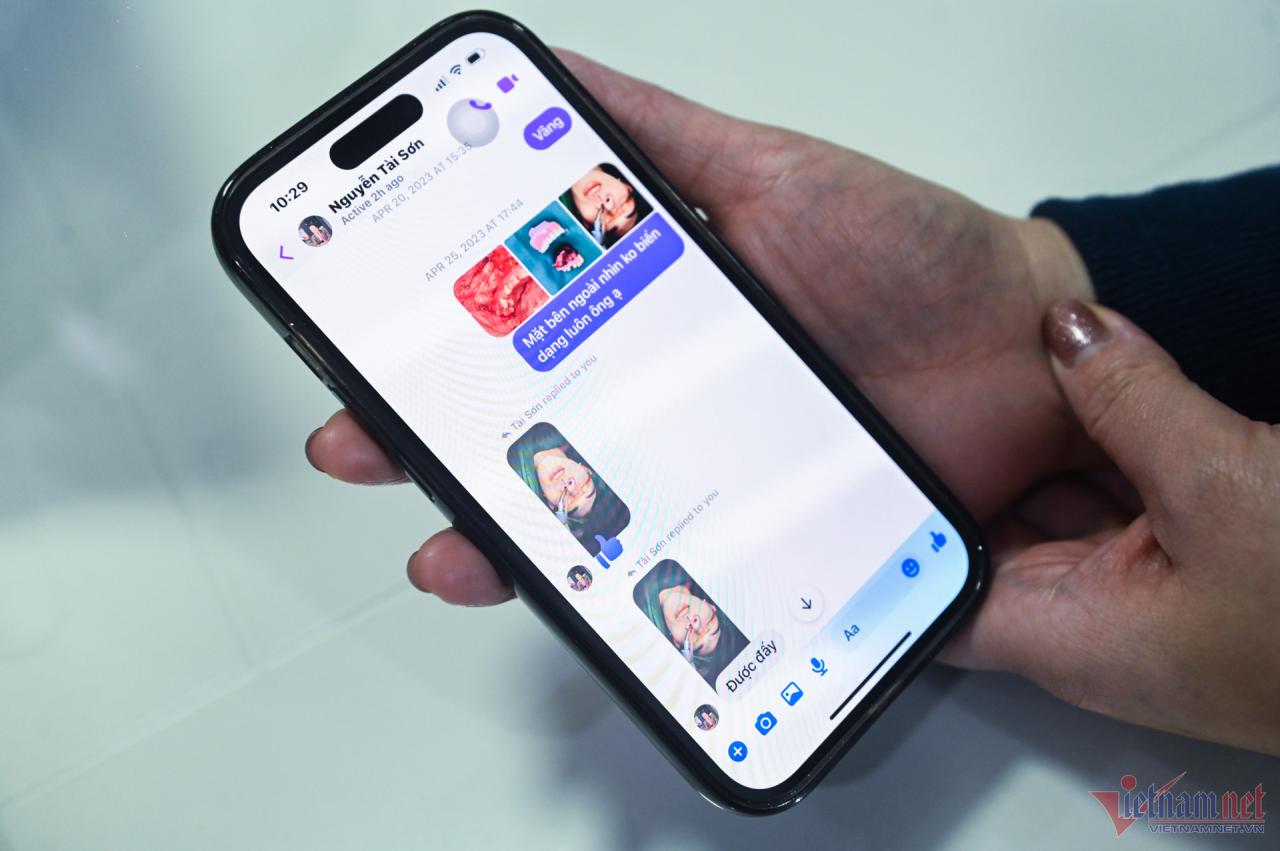 A habit that Professor Son and his daughter have been practicing for more than 10 years is taking photos and sending messages right after the surgery is over. "I have a habit of taking photos of the free flap taken and the damaged area that was treated after the surgery. Dad is the first person to receive those photos," Dr. Nhung shared. Many times, when he finished waiting for his daughter to send a photo but she hadn't sent him one yet, the professor proactively texted to "urge" her. Receiving his daughter's message and seeing the good results, he felt reassured and slowly replied briefly: 'That's good!', or more generously, he praised his daughter: 'Neat and clean', Dr. Nhung happily "showed off".
A habit that Professor Son and his daughter have been practicing for more than 10 years is taking photos and sending messages right after the surgery is over. "I have a habit of taking photos of the free flap taken and the damaged area that was treated after the surgery. Dad is the first person to receive those photos," Dr. Nhung shared. Many times, when he finished waiting for his daughter to send a photo but she hadn't sent him one yet, the professor proactively texted to "urge" her. Receiving his daughter's message and seeing the good results, he felt reassured and slowly replied briefly: 'That's good!', or more generously, he praised his daughter: 'Neat and clean', Dr. Nhung happily "showed off".  At the age of nearly 70, with about 40 years of experience, being the teacher of many generations of surgical and plastic surgery experts in the country, now retired, Professor Son still maintains the habit of observing like his daughter and younger generation colleagues doing microsurgery. Strict and sparing in compliments with his daughter, but when he comes across an image somewhere of a colleague performing a good suture, he immediately sends a text message of encouragement even though he does not know who that person is or which unit they work at. He is secretly proud of the development of this specialty, although in reality, very few young doctors are eager to engage in it. "International experts evaluate the skills and microsurgery techniques of Vietnamese doctors as being no less than anyone else, comparable to major centers in Taiwan, Japan, Korea... At prestigious international scientific conferences attended by thousands of experts in this field, the reports, or images sent, the results of Vietnamese doctors are considered even more satisfactory," the professor proudly shared. According to him, that development is thanks to the ability to absorb advanced world techniques, apply technology, techniques and work very effectively in groups of the younger generation. "This is completely different from before, when we were mainly responsible for ourselves," he said. Sharing more about the applications of digital technology and techniques in maxillofacial surgery and microsurgery, Dr. Nhung is proud of the virtual surgery model in which her team is one of the pioneers. According to the doctor, when shaping damaged defects, using digital techniques brings high precision to achieve aesthetic function. For example, in the case of a patient who has to have their jaw bone removed, the 2D films of the past will not be able to support the doctor as much as the 3D imaging films of today. The group of doctors also established a virtual surgery team before officially starting the real surgery. This team includes a person who takes data, a person who takes patient images, creates a 3D image, and then comes up with a surgical method based on digitizing the tumor incision design, measuring, and calculating the defect area. “Previously, creating a defect needed to rely on the technician's experience. For example, to cut the tissue on one side of the defective jawbone, the doctor had to measure the connecting part separately and create a symmetrical shape. The accuracy was only relative. With the support of digital technology, when cutting is finished, the virtual software can reconstruct the perfect face, from there calculate the distance, the defect to print out an accurate image, serving the actual bone cutting surgery later,” Dr. Nhung analyzed. Commenting on the superiority of the next generation, Dr. Son affirmed: “Even if the patient loses half or almost all of the jawbone, the face after surgery is almost unchanged. Moreover, the bite is well maintained, so dental restoration after surgery is very convenient. The patient wears dentures, the surgical scar is blurred, and it is difficult to detect that he has just undergone major surgery.”
At the age of nearly 70, with about 40 years of experience, being the teacher of many generations of surgical and plastic surgery experts in the country, now retired, Professor Son still maintains the habit of observing like his daughter and younger generation colleagues doing microsurgery. Strict and sparing in compliments with his daughter, but when he comes across an image somewhere of a colleague performing a good suture, he immediately sends a text message of encouragement even though he does not know who that person is or which unit they work at. He is secretly proud of the development of this specialty, although in reality, very few young doctors are eager to engage in it. "International experts evaluate the skills and microsurgery techniques of Vietnamese doctors as being no less than anyone else, comparable to major centers in Taiwan, Japan, Korea... At prestigious international scientific conferences attended by thousands of experts in this field, the reports, or images sent, the results of Vietnamese doctors are considered even more satisfactory," the professor proudly shared. According to him, that development is thanks to the ability to absorb advanced world techniques, apply technology, techniques and work very effectively in groups of the younger generation. "This is completely different from before, when we were mainly responsible for ourselves," he said. Sharing more about the applications of digital technology and techniques in maxillofacial surgery and microsurgery, Dr. Nhung is proud of the virtual surgery model in which her team is one of the pioneers. According to the doctor, when shaping damaged defects, using digital techniques brings high precision to achieve aesthetic function. For example, in the case of a patient who has to have their jaw bone removed, the 2D films of the past will not be able to support the doctor as much as the 3D imaging films of today. The group of doctors also established a virtual surgery team before officially starting the real surgery. This team includes a person who takes data, a person who takes patient images, creates a 3D image, and then comes up with a surgical method based on digitizing the tumor incision design, measuring, and calculating the defect area. “Previously, creating a defect needed to rely on the technician's experience. For example, to cut the tissue on one side of the defective jawbone, the doctor had to measure the connecting part separately and create a symmetrical shape. The accuracy was only relative. With the support of digital technology, when cutting is finished, the virtual software can reconstruct the perfect face, from there calculate the distance, the defect to print out an accurate image, serving the actual bone cutting surgery later,” Dr. Nhung analyzed. Commenting on the superiority of the next generation, Dr. Son affirmed: “Even if the patient loses half or almost all of the jawbone, the face after surgery is almost unchanged. Moreover, the bite is well maintained, so dental restoration after surgery is very convenient. The patient wears dentures, the surgical scar is blurred, and it is difficult to detect that he has just undergone major surgery.”
 The family of Professor Nguyen Tai Son, former Head of the Department of Maxillofacial Surgery and Plastic Surgery, 108 Central Military Hospital, has only one daughter, Dr. Nguyen Hong Nhung, 40 years old, currently working at Hospital E, and also a lecturer in the Department of Oral and Maxillofacial Surgery, University of Medicine and Pharmacy, Vietnam National University, Hanoi. The field of maxillofacial surgery and microsurgery in Vietnam is pursued by very few female doctors because it is very difficult and tiring. But for Dr. Hong Nhung to stand out in this field is a journey with many surprises and heartaches of Professor Son himself. "At first, Nhung did not want to take the medical exam, but I advised her to pursue this very humane field," the professor, who is about to turn 70 this year, began the story with VietNamNet. Dr. Nhung studied medicine in Russia, and every summer vacation, she returned to Hospital 108 to practice as a medical staff in different "roles". First as a nurse visiting and measuring blood pressure and temperature for patients, then a year later as a nurse, then as a doctor assisting in examining and monitoring patients. And so on.
The family of Professor Nguyen Tai Son, former Head of the Department of Maxillofacial Surgery and Plastic Surgery, 108 Central Military Hospital, has only one daughter, Dr. Nguyen Hong Nhung, 40 years old, currently working at Hospital E, and also a lecturer in the Department of Oral and Maxillofacial Surgery, University of Medicine and Pharmacy, Vietnam National University, Hanoi. The field of maxillofacial surgery and microsurgery in Vietnam is pursued by very few female doctors because it is very difficult and tiring. But for Dr. Hong Nhung to stand out in this field is a journey with many surprises and heartaches of Professor Son himself. "At first, Nhung did not want to take the medical exam, but I advised her to pursue this very humane field," the professor, who is about to turn 70 this year, began the story with VietNamNet. Dr. Nhung studied medicine in Russia, and every summer vacation, she returned to Hospital 108 to practice as a medical staff in different "roles". First as a nurse visiting and measuring blood pressure and temperature for patients, then a year later as a nurse, then as a doctor assisting in examining and monitoring patients. And so on.  At that time, Dr. Nguyen Tai Son was evaluated by his colleagues in the hospital as having the most talented hands in microsurgery, not only in the hospital but also in the country. He advised his son to pursue a career in medicine, but at that time, he never wanted his son to pursue his major, because "it is really good, but it is very hard". "Each microsurgery surgery lasts very long, usually 7-8 hours, not to mention complicated cases that last even longer. It can last all day and night, up to 22-24 hours continuously, with only 30 minutes of rest before continuing to fight", Professor Son recalled. In addition, post-operative monitoring is very important, even deciding the success of the entire microsurgery team. That monitoring is not only based on the patient's vital signs, but also the vital signs of the damaged area (due to tumor removal, scars, deformities due to trauma) and the free flap (healthy area taken to compensate for the damaged defect). If the free flap after surgery is not good and becomes necrotic, the surgery will be a complete failure. The patient will suffer two injuries. Therefore, in 2010, the 26-year-old daughter who graduated from medical school was advised by her father to become an Ophthalmologist because the job is light and more suitable for women. However, Dr. Nhung has always been a determined person since childhood, who loves challenges. "After going into the microsurgery operating room with my father to visit, watching him and his colleagues perform major surgeries, perhaps for the first time in my life I saw a plastic surgery that looked new and complicated and saw the surgical results that changed people's lives, I decided to pursue this major," he said. In fact, Dr. Nhung worked in the Ophthalmology department for only 30 days, then insisted on pursuing microsurgery. “When I insisted on pursuing this difficult and difficult profession, my father firmly objected, saying, ‘Why are you a girl pursuing this? Why don’t you choose a more gentle job that is more suitable for you?’. My father said that this profession requires physical strength, performing surgeries from morning to evening, and skipping meals is common, especially for those who have to take the lead in major surgeries. Not to mention that women also have to take care of their children and families. After surgery, the work is not over, but they still have to keep an eye on the patient even after they return home, and at night, when there is an unusual development, the doctor has to rush in to see the patient,” Dr. Nhung continued the story. But no matter how much her father and mother (who are also doctors) objected, they could not overcome the “falling in love” of their only “golden branch and jade leaf” daughter. Until now, more than 12 years after that day, Dr. Nhung clearly understood what her father said. “This job can save lives and restore a good life to many people who have fallen into the “abyss”, that is what motivated me to stick with the field of Microsurgery and Maxillofacial Surgery, which is considered not for women”, she said. “There are cases where after the surgery is done during the day, at midnight there is a phone call from the department and Nhung has to run in, only having time to tell the family that they have to go to the hospital to treat the patient, sometimes staying there until morning”, Dr. Son said. But she shared: If given the choice again, she would always choose this job.
At that time, Dr. Nguyen Tai Son was evaluated by his colleagues in the hospital as having the most talented hands in microsurgery, not only in the hospital but also in the country. He advised his son to pursue a career in medicine, but at that time, he never wanted his son to pursue his major, because "it is really good, but it is very hard". "Each microsurgery surgery lasts very long, usually 7-8 hours, not to mention complicated cases that last even longer. It can last all day and night, up to 22-24 hours continuously, with only 30 minutes of rest before continuing to fight", Professor Son recalled. In addition, post-operative monitoring is very important, even deciding the success of the entire microsurgery team. That monitoring is not only based on the patient's vital signs, but also the vital signs of the damaged area (due to tumor removal, scars, deformities due to trauma) and the free flap (healthy area taken to compensate for the damaged defect). If the free flap after surgery is not good and becomes necrotic, the surgery will be a complete failure. The patient will suffer two injuries. Therefore, in 2010, the 26-year-old daughter who graduated from medical school was advised by her father to become an Ophthalmologist because the job is light and more suitable for women. However, Dr. Nhung has always been a determined person since childhood, who loves challenges. "After going into the microsurgery operating room with my father to visit, watching him and his colleagues perform major surgeries, perhaps for the first time in my life I saw a plastic surgery that looked new and complicated and saw the surgical results that changed people's lives, I decided to pursue this major," he said. In fact, Dr. Nhung worked in the Ophthalmology department for only 30 days, then insisted on pursuing microsurgery. “When I insisted on pursuing this difficult and difficult profession, my father firmly objected, saying, ‘Why are you a girl pursuing this? Why don’t you choose a more gentle job that is more suitable for you?’. My father said that this profession requires physical strength, performing surgeries from morning to evening, and skipping meals is common, especially for those who have to take the lead in major surgeries. Not to mention that women also have to take care of their children and families. After surgery, the work is not over, but they still have to keep an eye on the patient even after they return home, and at night, when there is an unusual development, the doctor has to rush in to see the patient,” Dr. Nhung continued the story. But no matter how much her father and mother (who are also doctors) objected, they could not overcome the “falling in love” of their only “golden branch and jade leaf” daughter. Until now, more than 12 years after that day, Dr. Nhung clearly understood what her father said. “This job can save lives and restore a good life to many people who have fallen into the “abyss”, that is what motivated me to stick with the field of Microsurgery and Maxillofacial Surgery, which is considered not for women”, she said. “There are cases where after the surgery is done during the day, at midnight there is a phone call from the department and Nhung has to run in, only having time to tell the family that they have to go to the hospital to treat the patient, sometimes staying there until morning”, Dr. Son said. But she shared: If given the choice again, she would always choose this job.  In 2011, at the age of 27, Dr. Nhung began studying maxillofacial surgery and microsurgery. At that time, her father, Professor Son, was already a master in this field with 26 years of experience. But this leading expert himself admitted: "My daughter grew up surprisingly fast." The doctor still clearly remembers the days when his daughter and her friends practiced connecting blood vessels all afternoon. Connecting blood vessels on the belly of a mouse is very difficult because the blood vessels are tiny, less than 1mm in diameter, only the size of a round toothpick. While the shell is thin, adding a drop of water will make it transparent, but if no water is added, it cannot swell up, the two flattened shells stick together, making it even more impossible to thread a thread to connect. It was so difficult that many students gave up. However, at that time, young doctor Nguyen Hong Nhung was one of the students who successfully conquered it. Professor Son also clearly remembers the moment when he realized that his daughter, who thought she was a young lady, could pursue this surgical career. According to Dr. Son, who has nearly 30 years of experience in the profession, the most basic thing for a "microsurgeon" is to practice under a microscope and see if their hands are shaking. "If a surgeon is shaking, he will normally shake when holding surgical instruments, but under a microscope with a magnification of 20 times, if his hands are shaking, it will be like stirring porridge or beating blood pudding," he said. When he discovered that his daughter had a steady hand and a calm, worry-free face, he believed he had found his "successor".
In 2011, at the age of 27, Dr. Nhung began studying maxillofacial surgery and microsurgery. At that time, her father, Professor Son, was already a master in this field with 26 years of experience. But this leading expert himself admitted: "My daughter grew up surprisingly fast." The doctor still clearly remembers the days when his daughter and her friends practiced connecting blood vessels all afternoon. Connecting blood vessels on the belly of a mouse is very difficult because the blood vessels are tiny, less than 1mm in diameter, only the size of a round toothpick. While the shell is thin, adding a drop of water will make it transparent, but if no water is added, it cannot swell up, the two flattened shells stick together, making it even more impossible to thread a thread to connect. It was so difficult that many students gave up. However, at that time, young doctor Nguyen Hong Nhung was one of the students who successfully conquered it. Professor Son also clearly remembers the moment when he realized that his daughter, who thought she was a young lady, could pursue this surgical career. According to Dr. Son, who has nearly 30 years of experience in the profession, the most basic thing for a "microsurgeon" is to practice under a microscope and see if their hands are shaking. "If a surgeon is shaking, he will normally shake when holding surgical instruments, but under a microscope with a magnification of 20 times, if his hands are shaking, it will be like stirring porridge or beating blood pudding," he said. When he discovered that his daughter had a steady hand and a calm, worry-free face, he believed he had found his "successor".  After being guided by her father and practicing under supervision and independently suturing well, then going on to the steps of taking free flaps, dissecting, taking vessels, suturing, etc., the young female doctor surprised her "father and teacher" Nguyen Tai Son with her maturity. Although working at a different hospital, because they were in the same field, Dr. Nhung and her colleagues still invited Professor Nguyen Tai Son to the hospital for consultation, then invited him to perform a demonstration surgery to learn. "After a while, my father came to supervise so that my friends could feel secure in performing the surgery. If there were any difficulties or problems, he would ask right at the 'scene'. A few times like that, I was always by my daughter's side and her friends' side like a driving instructor. When I saw that my daughter was confident, I felt secure and let her drive herself," he recalled. In the first years of letting her be independent, Professor Son still had the habit of following his daughter's steps, knowing her surgery schedule every day, every week. "Every day my daughter had surgery, I would watch the end time, and when I saw that it was late and I hadn't received a text message from her, I would call to ask. Usually, the child would transfer the phone to the technician, always asking how the surgery was, if there were any difficulties, if the father needed help, "he said. Perhaps, it was the close and careful supervision from his father that made Dr. Nhung "strong" very quickly, even beyond the imagination of Professor Son and his colleagues. As people in the same profession, it was very normal for Dr. Son and his daughter to bring the patient home to discuss. Good cases and bad cases were all "dissected". "My daughter is not afraid to ask and argue", the professor humorously said about his unique daughter, whom he loved but was also very strict with.
After being guided by her father and practicing under supervision and independently suturing well, then going on to the steps of taking free flaps, dissecting, taking vessels, suturing, etc., the young female doctor surprised her "father and teacher" Nguyen Tai Son with her maturity. Although working at a different hospital, because they were in the same field, Dr. Nhung and her colleagues still invited Professor Nguyen Tai Son to the hospital for consultation, then invited him to perform a demonstration surgery to learn. "After a while, my father came to supervise so that my friends could feel secure in performing the surgery. If there were any difficulties or problems, he would ask right at the 'scene'. A few times like that, I was always by my daughter's side and her friends' side like a driving instructor. When I saw that my daughter was confident, I felt secure and let her drive herself," he recalled. In the first years of letting her be independent, Professor Son still had the habit of following his daughter's steps, knowing her surgery schedule every day, every week. "Every day my daughter had surgery, I would watch the end time, and when I saw that it was late and I hadn't received a text message from her, I would call to ask. Usually, the child would transfer the phone to the technician, always asking how the surgery was, if there were any difficulties, if the father needed help, "he said. Perhaps, it was the close and careful supervision from his father that made Dr. Nhung "strong" very quickly, even beyond the imagination of Professor Son and his colleagues. As people in the same profession, it was very normal for Dr. Son and his daughter to bring the patient home to discuss. Good cases and bad cases were all "dissected". "My daughter is not afraid to ask and argue", the professor humorously said about his unique daughter, whom he loved but was also very strict with.  A habit that Professor Son and his daughter have been practicing for more than 10 years is taking photos and sending messages right after the surgery is over. "I have a habit of taking photos of the free flap taken and the damaged area that was treated after the surgery. Dad is the first person to receive those photos," Dr. Nhung shared. Many times, when he finished waiting for his daughter to send a photo but she hadn't sent him one yet, the professor proactively texted to "urge" her. Receiving his daughter's message and seeing the good results, he felt reassured and slowly replied briefly: 'That's good!', or more generously, he praised his daughter: 'Neat and clean', Dr. Nhung happily "showed off".
A habit that Professor Son and his daughter have been practicing for more than 10 years is taking photos and sending messages right after the surgery is over. "I have a habit of taking photos of the free flap taken and the damaged area that was treated after the surgery. Dad is the first person to receive those photos," Dr. Nhung shared. Many times, when he finished waiting for his daughter to send a photo but she hadn't sent him one yet, the professor proactively texted to "urge" her. Receiving his daughter's message and seeing the good results, he felt reassured and slowly replied briefly: 'That's good!', or more generously, he praised his daughter: 'Neat and clean', Dr. Nhung happily "showed off".  At the age of nearly 70, with about 40 years of experience, being the teacher of many generations of surgical and plastic surgery experts in the country, now retired, Professor Son still maintains the habit of observing like his daughter and younger generation colleagues doing microsurgery. Strict and sparing in compliments with his daughter, but when he comes across an image somewhere of a colleague performing a good suture, he immediately sends a text message of encouragement even though he does not know who that person is or which unit they work at. He is secretly proud of the development of this specialty, although in reality, very few young doctors are eager to engage in it. "International experts evaluate the skills and microsurgery techniques of Vietnamese doctors as being no less than anyone else, comparable to major centers in Taiwan, Japan, Korea... At prestigious international scientific conferences attended by thousands of experts in this field, the reports, or images sent, the results of Vietnamese doctors are considered even more satisfactory," the professor proudly shared. According to him, that development is thanks to the ability to absorb advanced world techniques, apply technology, techniques and work very effectively in groups of the younger generation. "This is completely different from before, when we were mainly responsible for ourselves," he said. Sharing more about the applications of digital technology and techniques in maxillofacial surgery and microsurgery, Dr. Nhung is proud of the virtual surgery model in which her team is one of the pioneers. According to the doctor, when shaping damaged defects, using digital techniques brings high precision to achieve aesthetic function. For example, in the case of a patient who has to have their jaw bone removed, the 2D films of the past will not be able to support the doctor as much as the 3D imaging films of today. The group of doctors also established a virtual surgery team before officially starting the real surgery. This team includes a person who takes data, a person who takes patient images, creates a 3D image, and then comes up with a surgical method based on digitizing the tumor incision design, measuring, and calculating the defect area. “Previously, creating a defect needed to rely on the technician's experience. For example, to cut the tissue on one side of the defective jawbone, the doctor had to measure the connecting part separately and create a symmetrical shape. The accuracy was only relative. With the support of digital technology, when cutting is finished, the virtual software can reconstruct the perfect face, from there calculate the distance, the defect to print out an accurate image, serving the actual bone cutting surgery later,” Dr. Nhung analyzed. Commenting on the superiority of the next generation, Dr. Son affirmed: “Even if the patient loses half or almost all of the jawbone, the face after surgery is almost unchanged. Moreover, the bite is well maintained, so dental restoration after surgery is very convenient. The patient wears dentures, the surgical scar is blurred, and it is difficult to detect that he has just undergone major surgery.”
At the age of nearly 70, with about 40 years of experience, being the teacher of many generations of surgical and plastic surgery experts in the country, now retired, Professor Son still maintains the habit of observing like his daughter and younger generation colleagues doing microsurgery. Strict and sparing in compliments with his daughter, but when he comes across an image somewhere of a colleague performing a good suture, he immediately sends a text message of encouragement even though he does not know who that person is or which unit they work at. He is secretly proud of the development of this specialty, although in reality, very few young doctors are eager to engage in it. "International experts evaluate the skills and microsurgery techniques of Vietnamese doctors as being no less than anyone else, comparable to major centers in Taiwan, Japan, Korea... At prestigious international scientific conferences attended by thousands of experts in this field, the reports, or images sent, the results of Vietnamese doctors are considered even more satisfactory," the professor proudly shared. According to him, that development is thanks to the ability to absorb advanced world techniques, apply technology, techniques and work very effectively in groups of the younger generation. "This is completely different from before, when we were mainly responsible for ourselves," he said. Sharing more about the applications of digital technology and techniques in maxillofacial surgery and microsurgery, Dr. Nhung is proud of the virtual surgery model in which her team is one of the pioneers. According to the doctor, when shaping damaged defects, using digital techniques brings high precision to achieve aesthetic function. For example, in the case of a patient who has to have their jaw bone removed, the 2D films of the past will not be able to support the doctor as much as the 3D imaging films of today. The group of doctors also established a virtual surgery team before officially starting the real surgery. This team includes a person who takes data, a person who takes patient images, creates a 3D image, and then comes up with a surgical method based on digitizing the tumor incision design, measuring, and calculating the defect area. “Previously, creating a defect needed to rely on the technician's experience. For example, to cut the tissue on one side of the defective jawbone, the doctor had to measure the connecting part separately and create a symmetrical shape. The accuracy was only relative. With the support of digital technology, when cutting is finished, the virtual software can reconstruct the perfect face, from there calculate the distance, the defect to print out an accurate image, serving the actual bone cutting surgery later,” Dr. Nhung analyzed. Commenting on the superiority of the next generation, Dr. Son affirmed: “Even if the patient loses half or almost all of the jawbone, the face after surgery is almost unchanged. Moreover, the bite is well maintained, so dental restoration after surgery is very convenient. The patient wears dentures, the surgical scar is blurred, and it is difficult to detect that he has just undergone major surgery.”Vo Thu - Vietnamnet.vn
Source







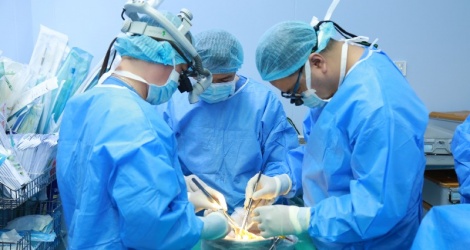



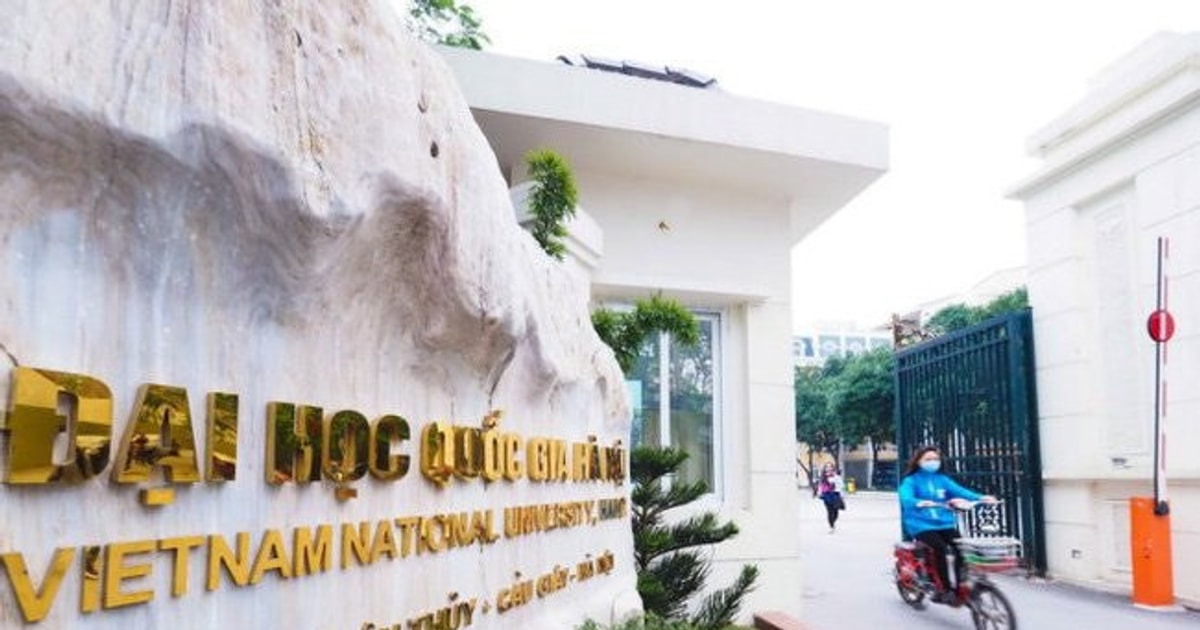

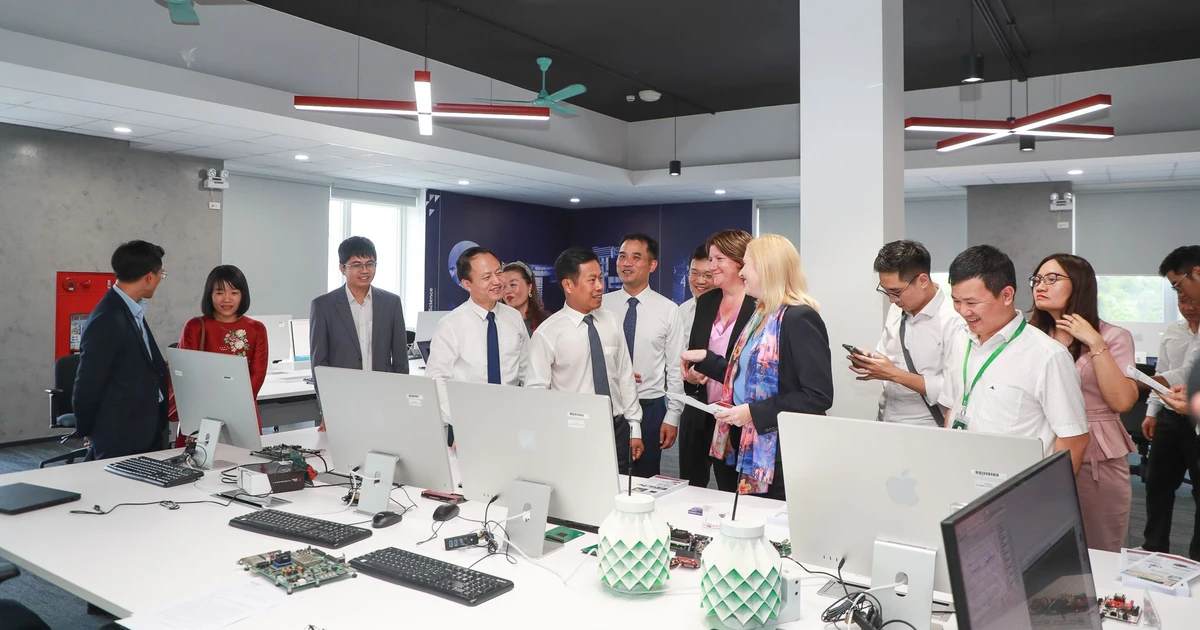

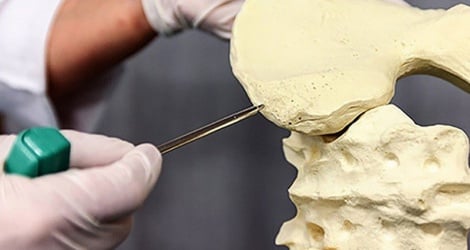
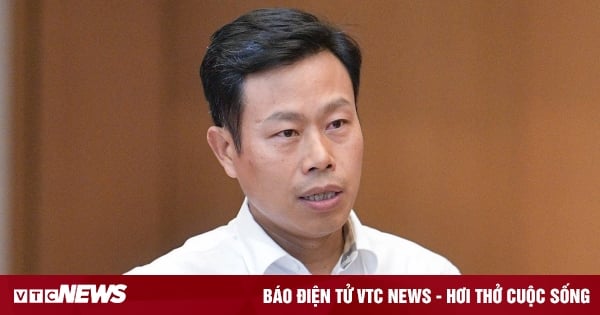







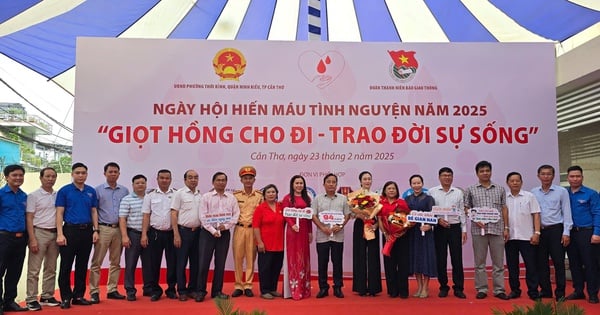




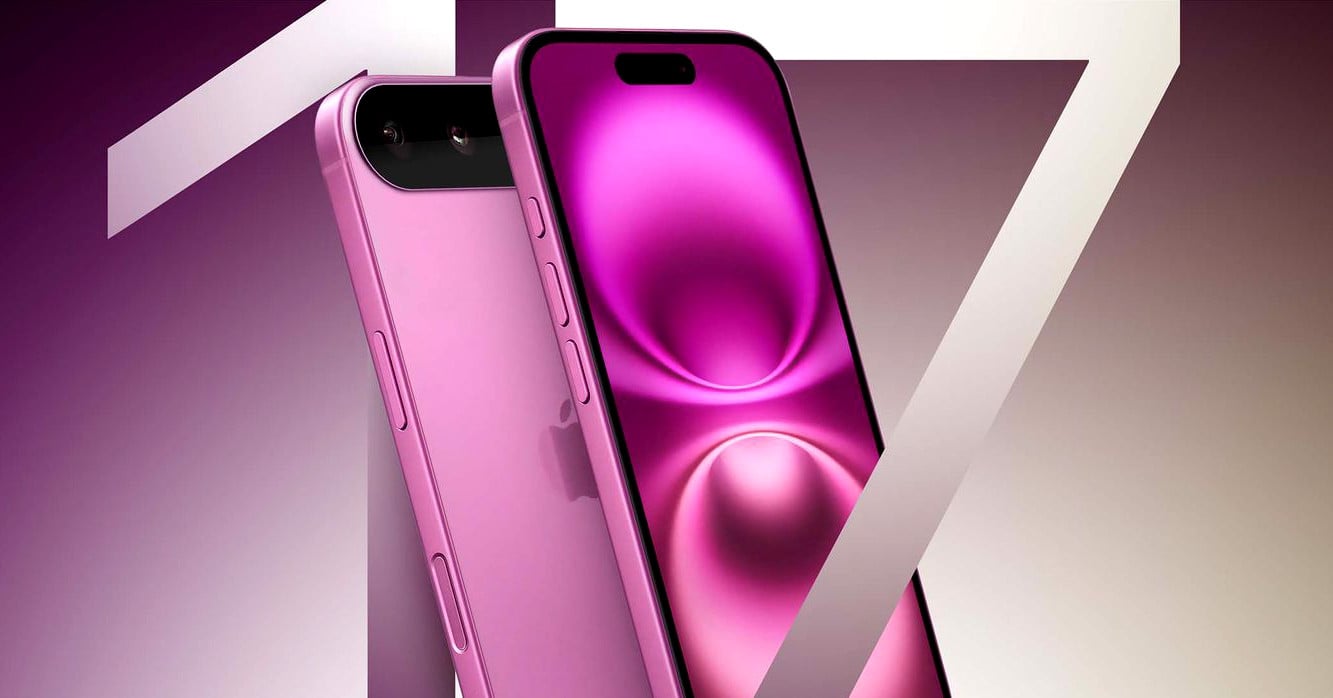










Comment (0)